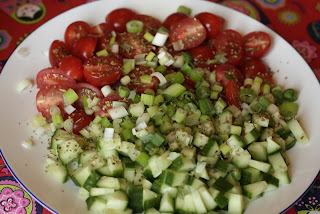When I go to the Wing Sing in Edinburgh, I always order the yu hung aubergine - stewed, spicy aubergine with a bit of pork mince. Usually we order far too much and end up bringing home the aubergine in a container for the next day. The last time we did this, we reheated it on the barbecue and had it in mini pitta breads, and it was great, so I thought it was time I found out how to make it for myself.

After a bit of hunting around on the web I found this recipe for
eggplant in garlic sauce at about.com. The technique involves quickly boiling the aubergine before stir-frying and then stewing it. I've left the pork out (because I didn't have any in the fridge) but will post a meaty version shortly. There is a frightening amount of soy sauce in this, but be brave - it's right! The end result should be almost 'jammy'. (Thanks to Alan for pointing that out - the first time I made it, I forgot to put the cornflour in, so it was a bit too liquid.)
Ingredients
750g aubergine
2 teaspoons minced garlic
2 teaspoons minced ginger
2 teaspoons minced chilli (I use the prepared version, alternatively use very finely chopped fresh chilli)
4 spring onions, white and green parts, finely chopped
2 teaspoons of cornflour
2 tablespoons of water
1 tablespoon of vegetable oil
Sauce ingredients
50 ml dark soy sauce
50 ml light soy sauce
35 ml balsamic vinegar
35 ml Chinese rice wine or dry sherry or dry white wine
1 teaspoon sugar
150 ml chicken stock
Method
- Boil a large saucepan of water. In the meantime, top and tail the aubergine, cut into three or four segments crosswise, then cut each segment vertically into nine wedges.
- Put the aubergine in the saucepan of boiling water, bring back to the boil, and cook for 1 minute (timed from when the water returns to the boil). Drain the aubergine pieces, then spread out to dry a little on kitchen paper.
- Mince the garlic and ginger and chop the spring onion. In a bowl, combine the sauce ingredients (the dark and light soy sauce, vinegar, rice wine or dry sherry, sugar and chicken stock).
- Heat the wok with the vegetable oil until it is hot. Add the garlic, ginger, spring onion and chilli. Stir-fry for 10 seconds. Add the aubergine and the sauce ingredients, mix well, bring to a simmer, and continue cooking on a medium heat for about 10 minutes until the aubergine is tender.
- Mix the cornflour and the water together thoroughly, and add to the wok, stirring well as you do so. Heat gently for another minute or so until the sauce thickens.





























